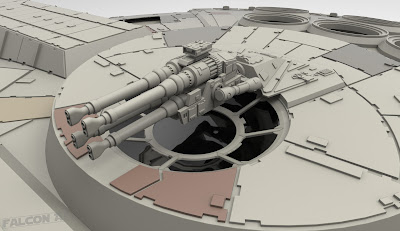There's no other way to say it; the Millennium Falcon's guns are confusing. The first time they were used on screen was in A New Hope after the ship fled the Death Star pursued by a squadron of Tie Fighters. Han ascends up a ladder to the dorsal gunpit...
followed by Luke who descends to the ventral gunpit.
They sit in the gunpits perpendicular to the rest of the ship, with the ladder on the floor behind them. Since we know what the exterior of the ship looks like, we know that their feet are facing in the forward direction. This is in opposition of the gravity of the rest of the ship, but we'll give them a pass since these ships have to have artificial gravity anyway.
Where this starts to fall apart is when you look at the side view of the ship and see that there's no way both gunpits AND a tube with a ladder in it would never fit inside the ship.
Anyway, they sit in the gunpits looking out the top and bottom of the ship with the quad laser cannons hanging in front of the window from above.
The quad laser cannon is mounted on a gimbal fork which allows it to rotate in almost every direction.
It's important to note the use of a targeting computer in this scene because despite the range of motion of the quad laser cannon the visibility from the gunpit is just terrible.
Han and Luke manage to take out all of the Tie Fighters and the Millennium Falcon continues on to Yavin. We don't see the gunpits in action again until The Force Awakens (apart from the deleted scenes from Return of the Jedi, which would have been awesome!)
Finn and Rey enter the Millennium Falcon on Jakku and Finn climbs down the ladder to the ventral gunpit (why he wouldn't go to the dorsal gunpit I'll never understand).
He gets down to the gunpit and sits in the chair and the quad laser cannon is now sticking up in front of the window from below his feet.
So why the difference? WELL... we know that the tube that leads to the gunpits is opposite the corridor that leads to the cockpit and because of that facing the ladder means facing the center of the ship. Since the quad laser cannons are mounted at the center of the ship and the ladder is behind the gunners' chairs at their feet then it makes sense that the gun mount would also be at their feet. There's also the matter of the cockpit tube being at a 60 degree angle from the center of the ship though; to make sense of that the core caps in The Force Awakens have the ability to rotate! While we don't see it happen explicitly, the evidence is there. Just look at these two shots. The core caps do a 180!
The diagram below shows how The Force Awakens made sense of the Falcon's guns. The rotation of the core caps is explained in The Force Awakens Cross Sections book as a refurbishment by the gunrunner Gannis Ducain, so this is an addition made after the original trilogy.
This solution makes sense to me, but I have to say I don't like it! To have such a large piece of the ship rotating seems mechanically infeasible. The gimbal fork allows the quad laser cannons to face any direction, so there's no need for any core rotation, but even if the core could rotate, the access tube binds them together so the gunners would be forced to rotate in the same direction. This seems to me like a tactical disadvantage in a dogfight. There's also this shot from The Force Awakens:
This seems to suggest that the core caps aren't connected in any way... but we always see the tube behind the gunners. The guns are inexplicably facing forward again in the very next shot:
It hurts my brain! I do appreciate the effort to make the design work, but my solution to this problem would probably be something more like what is illustrated in the Haynes Manual, an angled hallway that leads to the gunpit. That of course would mean a redesign of the set, which I suppose would be more noticeable.
At the end of the day though... why even try to solve the problem? The Millennium Falcon is a physical impossibility in many ways. No two Falcon models are alike, no two sets are the same, and no combination of either fits together perfectly, but when watching it on film none of that matters. I love the gunpit scenes in both A New Hope and The Force Awakens because they're exciting and I love to see the Falcon in action. As I write this I am in progress on modeling an interior that doesn't fit whatsoever with the exterior of the ship, and that is just fine by me!
If you've made it this far, you're awesome! I'm sorry if this post became too much of a nerd rant!
Next time: a primer on greeblies!



















































